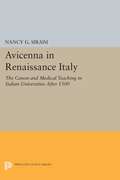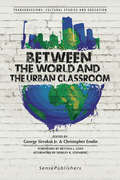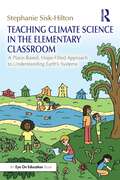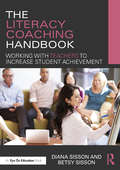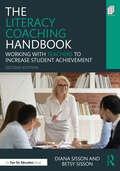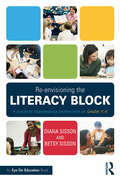- Table View
- List View
Avicenna in Renaissance Italy: The Canon and Medical Teaching in Italian Universities after 1500 (PDF)
by Nancy G. SiraisiThe Canon of Avicenna, one of the principal texts of Arabic origin to be assimilated into the medical learning of medieval Europe, retained importance in Renaissance and early modern European medicine. After surveying the medieval reception of the book, Nancy Siraisi focuses on the Canon in sixteenth- and early seventeenth-century Italy, and especially on its role in the university teaching of philosophy of medicine and physiological theory.Originally published in 1987.The Princeton Legacy Library uses the latest print-on-demand technology to again make available previously out-of-print books from the distinguished backlist of Princeton University Press. These editions preserve the original texts of these important books while presenting them in durable paperback and hardcover editions. The goal of the Princeton Legacy Library is to vastly increase access to the rich scholarly heritage found in the thousands of books published by Princeton University Press since its founding in 1905.
The Sustained Shared Thinking and Emotional Well-being (SSTEW) Scale: Supporting Process Quality in Early Childhood
by Iram Siraj Denise Kingston Edward MelhuishFirst published in 2015, The SSTEW Scale has been widely used in early childhood education and care, in all sectors across the world, to enhance the quality of education, and monitor and assess practice. It explores pedagogy and practice that improve children’s social-emotional development, self-regulation, language, and critical thinking. The SSTEW Scale is an innovative method of assessing the process quality of an early years education environment and pedagogy. It promotes practice where staff provide sensitive, responsive relationships and high-quality interactions, which includes supporting children’s social, emotional and communication skills. This scale also helps educators to engage children in thinking deeply, problem solving and reasoning, including items which support the four competencies: critical thinking, creativity, communication and collaboration, all identified as life-long skills needed for all children in the 21st century by the World Economic Forum in 2016. This new edition includes updated information about the evidence-base for SSTEW and children’s development and learning as well as the expansion of examples and supplementary information accompanying the indicators. In addition, there is a stronger focus on formative assessment and new additions to the assessment section. The SSTEW Scale can be used to support research, auditing and practice uplift. It is a key text for the sector to assess and improve the quality of provision during audits, and for educators seeking professional development by improving their knowledge of excellent practice.
The Sustained Shared Thinking and Emotional Well-being (SSTEW) Scale: Supporting Process Quality in Early Childhood
by Iram Siraj Denise Kingston Edward MelhuishFirst published in 2015, The SSTEW Scale has been widely used in early childhood education and care, in all sectors across the world, to enhance the quality of education, and monitor and assess practice. It explores pedagogy and practice that improve children’s social-emotional development, self-regulation, language, and critical thinking. The SSTEW Scale is an innovative method of assessing the process quality of an early years education environment and pedagogy. It promotes practice where staff provide sensitive, responsive relationships and high-quality interactions, which includes supporting children’s social, emotional and communication skills. This scale also helps educators to engage children in thinking deeply, problem solving and reasoning, including items which support the four competencies: critical thinking, creativity, communication and collaboration, all identified as life-long skills needed for all children in the 21st century by the World Economic Forum in 2016. This new edition includes updated information about the evidence-base for SSTEW and children’s development and learning as well as the expansion of examples and supplementary information accompanying the indicators. In addition, there is a stronger focus on formative assessment and new additions to the assessment section. The SSTEW Scale can be used to support research, auditing and practice uplift. It is a key text for the sector to assess and improve the quality of provision during audits, and for educators seeking professional development by improving their knowledge of excellent practice.
Supp. Identity, Diversity & Language in the Early Years (UK Higher Education OUP Humanities & Social Sciences Education OUP)
by Iram Siraj-Blatchford Priscilla ClarkeThis book provides the main ingredients for professional development in working with young children in a diverse society. It fills the gap that most early years training neglects, that is, how to work with children in developing a positive disposition towards themselves regardless of their differences. By helping children to develop a strong self-identity and good self-esteem we set the foundations for positive attitudes towards others and towards learning. Practical advice, real examples and staff activities bring the book to life. The book provides clear evidence and practical guidance on how to develop young children's emerging language, especially those children who have English as an additional language, and how to generate, activate and assess curriculum for diversity. The book focuses on all children's learning for cultural diversity. Culture is used as a broad term to include language, ethnicity, social class and gender. Each chapter offers a clear combination of theory and practice and ends with excellent staff development activities and further readings. The book will be important reading for all students and practitioners working with young children.
Effective Leadership in the Early Years Sector: The Eleys Study (PDF) (Issues In Practice Ser.)
by Iram Siraj-Blatchford Laura Manni Lesley SaundersThis publication takes as its background the radical reforms to services for children following the passing of The Children Act of 2004 and the subsequent Government White Paper, Every Child Matters: Change for children. It argues that the fundamental requirements for leadership for learning in the early years should be provided by considering social contexts, adopting a commitment to collective working, and focusing on improving children's learning outcomes. This book analyses a wide range of literature on leadership in the early years settings, as identified in studies funded by the Department for Education and Skills. It identifies a range of "categories of effective leadership practice" in the effective settings that will be valuable in the development of leadership training. It is very timely, as the Early Years Foundation Stage (EYFS) Curriculum came into force in September 2008.
International Research on Education for Sustainable Development in Early Childhood (International Perspectives on Early Childhood Education and Development #14)
by John Siraj-Blatchford Cathy Mogharreban Eunhye ParkThis book offers a perspective on Education for Sustainable Development in Early Childhood (ESDEC) that is far removed from the ‘business as usual’ notion of an extended, predominantly environmental, educational curriculum for preschools. It presents a vision of sustainable development that has relevance to Early Childhood Care and Education (ECCE) from birth to school; it is relevant as much to homes, family support and health settings as it is to educational settings, and is as much concerned with health and wellbeing as with education. The book provides a perspective that is fundamentally embedded in notions of interdependency. It places an emphasis upon the importance of recognising the interdependency of peoples within and between nation states; the ecological interdependencies of the natural world; of humanity and nature; and most significantly the interdependency of adults and children. These emphases have their origins in the grassroots studies included in the ten chapters representing countries from around the world. The book reflects the idea that only global solutions and initiatives are capable of addressing the global challenges of climate change, environmental pollution, and global threats to ecological systems and biodiversity.
Between the World and the Urban Classroom (Transgressions)
by George Sirrakos Jr. Christopher EmdinBorrowing from the ideas of John Dewey, schools and classrooms are a reflection of the world; therefore, in order to make sense of the urban classroom, we need to make sense of the world. In this book, the editors have compiled a collection of nine critical essays, or chapters, each examining a particular contemporary national and/or international event. The essays each undertake an explicit approach to naming oppression and addressing it in the context of urban schooling. Each essay has a two-fold purpose. The first purpose is to help readers see the world unveiled, through a more critical lens, and to problematize long held beliefs about urban classrooms, with regard to race, gender, social class, equity, and access. Second, as each author draws parallels between an event and urban classrooms, a better understanding of the microstructures that exist in urban classrooms emerges. “At a time of serious political, economic, and social uncertainty, we need a book like this, one that showcases how the world can be seen as a critical site of curriculum and pedagogy. A powerful intersectional analysis of the world, word, and urban sociopolitical context, authors in this book push the boundaries of what educators know and do in urban schools and classrooms. Grounded in frameworks of critical race theory and culturally relevant pedagogy, authors center essential societal moments that must be viewed as the real curriculum. These moments can equip students with tools to examine ‘the what of the world’ as well as how to examine, critique, challenge, and disrupt individual, systemic, and structural realities and practices that perpetuate and maintain a racist, sexist, homophobic, and xenophobic status quo. This is an important, forward-thinking, innovative book – a welcome addition to the field of urban education.” – H. Richard Milner IV, Helen Faison Chair of Urban Education, University of Pittsburgh
Teaching Climate Science in the Elementary Classroom: A Place-Based, Hope-Filled Approach to Understanding Earth’s Systems
by Stephanie Sisk-HiltonDiscover new ways to help elementary students engage with and understand the world around them through place-based, hope-filled learning about the causes, impacts, and responses to climate change. This book features foundational climate concepts, easily implementable activity plans, and inspiring examples of student engagement. Each chapter begins with a short vignette pulled from the author’s considerable teaching experience in engaging students in concepts of climate change and climate justice, followed by content-focused sections and recommendations for student activities and projects. The author provides stories of hope-filled action to invite teachers to look for and reflect on similar narratives in their own communities. Sample units of study for grades K-5 show teachers how key ideas from each chapter come together into an instructional plan that incorporates the three dimensions of NGSS and can fit into the broader outline of their school year. This resource is an accessible tool to support any elementary educator in building their own knowledge base and integrating the important and timely issues of climate change into their classroom.
Teaching Climate Science in the Elementary Classroom: A Place-Based, Hope-Filled Approach to Understanding Earth’s Systems
by Stephanie Sisk-HiltonDiscover new ways to help elementary students engage with and understand the world around them through place-based, hope-filled learning about the causes, impacts, and responses to climate change. This book features foundational climate concepts, easily implementable activity plans, and inspiring examples of student engagement. Each chapter begins with a short vignette pulled from the author’s considerable teaching experience in engaging students in concepts of climate change and climate justice, followed by content-focused sections and recommendations for student activities and projects. The author provides stories of hope-filled action to invite teachers to look for and reflect on similar narratives in their own communities. Sample units of study for grades K-5 show teachers how key ideas from each chapter come together into an instructional plan that incorporates the three dimensions of NGSS and can fit into the broader outline of their school year. This resource is an accessible tool to support any elementary educator in building their own knowledge base and integrating the important and timely issues of climate change into their classroom.
Realms Of Knowledge: Academic Departments In Secondary Schools
by Leslie Santee SiskinThis study examines academic departments as a context for teaching in the secondary school. lt explores why teachers find departments to be crucial to the high school setting. In all three schools studied and in all four subjects English, Maths, Science and Social Science teachers - even those who felt isolated in their classrooms - located their sense of professional identity, practice and community in their departments. Departments are seen as boundaries for dividing the school; centres of social interaction; a micro political decision-making forum; as a subject knowledge category. Those concerns are important at this time as various attacks are being made on school structures and subject and administration fragmentation - in these cases subjects are seen as obstacles to change. To subject groups they are viewed as potential vehicles to carry and confirm the message.
Realms Of Knowledge: Academic Departments In Secondary Schools
by Leslie Santee SiskinThis study examines academic departments as a context for teaching in the secondary school. lt explores why teachers find departments to be crucial to the high school setting. In all three schools studied and in all four subjects English, Maths, Science and Social Science teachers - even those who felt isolated in their classrooms - located their sense of professional identity, practice and community in their departments. Departments are seen as boundaries for dividing the school; centres of social interaction; a micro political decision-making forum; as a subject knowledge category. Those concerns are important at this time as various attacks are being made on school structures and subject and administration fragmentation - in these cases subjects are seen as obstacles to change. To subject groups they are viewed as potential vehicles to carry and confirm the message.
Staff, Parents and Politics in Head Start: A Case Study in Unequal Power, Knowledge and Material Resources (Studies in Education/Politics)
by Peggy A. SisselThis book takes the reader inside the workings of Head Start, drawing attention to the inequalities in power, knowledge, and material resources that exist in the United States. It traces the dialectical relationship between the thoughts and actions of staff members and parents.
Staff, Parents and Politics in Head Start: A Case Study in Unequal Power, Knowledge and Material Resources (Studies in Education/Politics #No. 4)
by Peggy A. SisselThis book takes the reader inside the workings of Head Start, drawing attention to the inequalities in power, knowledge, and material resources that exist in the United States. It traces the dialectical relationship between the thoughts and actions of staff members and parents.
Ophthalmic Imaging: Posterior Segment Imaging, Anterior Eye Photography, and Slit Lamp Biomicrography (Applications in Scientific Photography)
by Christye SissonOphthalmic Imaging serves as a reference for the practicing ophthalmic imager. Ophthalmic imaging combines photography and diagnostic imaging to provide insight into not only the health of the eye, but also the health of the human body as a whole. Ophthalmic photographers are specialists in imaging through and in the human eye, one of the only parts of the body where the circulation and nervous system is visible non-invasively. With technical perspective as context, this book will provide instructional techniques as well as the background needed for problem solving in this exciting field. The book covers all aspects of contemporary ophthalmic imaging and provides image support to ophthalmologists and sub-specialties including retinal specialists, corneal specialists, neuro-ophthalmologists, and ocular oncologists. This text serves as a reference for the practicing ophthalmic imager, or to imagers just getting started in the field.
Ophthalmic Imaging: Posterior Segment Imaging, Anterior Eye Photography, and Slit Lamp Biomicrography (Applications in Scientific Photography)
by Christye SissonOphthalmic Imaging serves as a reference for the practicing ophthalmic imager. Ophthalmic imaging combines photography and diagnostic imaging to provide insight into not only the health of the eye, but also the health of the human body as a whole. Ophthalmic photographers are specialists in imaging through and in the human eye, one of the only parts of the body where the circulation and nervous system is visible non-invasively. With technical perspective as context, this book will provide instructional techniques as well as the background needed for problem solving in this exciting field. The book covers all aspects of contemporary ophthalmic imaging and provides image support to ophthalmologists and sub-specialties including retinal specialists, corneal specialists, neuro-ophthalmologists, and ocular oncologists. This text serves as a reference for the practicing ophthalmic imager, or to imagers just getting started in the field.
Close Reading in Elementary School: Bringing Readers and Texts Together
by Diana Sisson Betsy SissonThe Common Core State Standards encourage teachers to use close reading as a means to help students access complex text. Many literacy experts believe close reading has the power to create strong, independent readers. But what does that really mean, and how does it work in the classroom?This book is your must-have guide to getting started! It provides step-by-step strategies and scaffolds for teaching close reading and improving students’ comprehension of complex texts. You will learn how to teach close reading based on text type, how to transition students through increasingly challenging texts, and how to use close reading as a springboard for close writes and close talks. Special Features:• An easy-to-use framework for creating a close reading lesson• Close reading strategies for a variety of literary and informational subgenres• Ideas for teaching close reading to meet specific comprehension objectives based on the Common Core, including analyzing text structure and evaluating argument• Suggestions for helping students read with increased levels of rigor• A clear explanation of what text complexity really means and how it varies by student• Scaffolds to help students at all ability levels do a close reading• Guidelines and procedures for close talks—purposeful, focused discussions about text• Procedures for close writes that vary based on genre and student ability level In addition, each chapter includes study guide questions to help you apply the ideas in the book to your own classroom. With this practical book, you will have all the tools you need to make close reading a reality!
Close Reading in Elementary School: Bringing Readers and Texts Together
by Diana Sisson Betsy SissonThe Common Core State Standards encourage teachers to use close reading as a means to help students access complex text. Many literacy experts believe close reading has the power to create strong, independent readers. But what does that really mean, and how does it work in the classroom?This book is your must-have guide to getting started! It provides step-by-step strategies and scaffolds for teaching close reading and improving students’ comprehension of complex texts. You will learn how to teach close reading based on text type, how to transition students through increasingly challenging texts, and how to use close reading as a springboard for close writes and close talks. Special Features:• An easy-to-use framework for creating a close reading lesson• Close reading strategies for a variety of literary and informational subgenres• Ideas for teaching close reading to meet specific comprehension objectives based on the Common Core, including analyzing text structure and evaluating argument• Suggestions for helping students read with increased levels of rigor• A clear explanation of what text complexity really means and how it varies by student• Scaffolds to help students at all ability levels do a close reading• Guidelines and procedures for close talks—purposeful, focused discussions about text• Procedures for close writes that vary based on genre and student ability level In addition, each chapter includes study guide questions to help you apply the ideas in the book to your own classroom. With this practical book, you will have all the tools you need to make close reading a reality!
Close Reading in Elementary School: Bringing Readers and Texts Together
by Diana Sisson Betsy SissonMany literacy experts believe close reading has the power to create strong, independent readers, but what does that really mean, and how does it work in the classroom? This book is your must-have guide to getting started! It provides step-by-step strategies and scaffolds for teaching close reading and improving students’ comprehension of complex texts. You will learn how to teach close reading based on text type, how to accelerate learning through increasingly challenging texts in both print and digital media, how to use close reading as a springboard for close talks and close writes, and how to support your students to move forward confidently with a repertoire of tools to employ as they navigate complex text in their daily lives.Special Features: A clear explanation of what text complexity really means and how it varies by student An easy-to-use framework for creating a close reading lesson that builds student reading stamina Scaffolds to help students at all ability levels to do a close reading Close reading strategies for a variety of literary and informational genres Ideas for strengthening reading through targeting comprehension skills, including analyzing text structure and evaluating arguments Suggestions for helping students read with increasing levels of rigor Techniques for how to lessen student technology distractions and dig deeper into digital text Guidelines and procedures for close talks – purposeful, focused discussions about text Procedures for close writes that vary based on genre and student ability level Recommendations to ensure students have the close reading skills to be effective readers in and out of the classroom In addition, each chapter includes study guide questions to help you apply the ideas in the book to your own classroom. With this practical book, you will have all the tools you need to make close reading a reality!
Close Reading in Elementary School: Bringing Readers and Texts Together
by Diana Sisson Betsy SissonMany literacy experts believe close reading has the power to create strong, independent readers, but what does that really mean, and how does it work in the classroom? This book is your must-have guide to getting started! It provides step-by-step strategies and scaffolds for teaching close reading and improving students’ comprehension of complex texts. You will learn how to teach close reading based on text type, how to accelerate learning through increasingly challenging texts in both print and digital media, how to use close reading as a springboard for close talks and close writes, and how to support your students to move forward confidently with a repertoire of tools to employ as they navigate complex text in their daily lives.Special Features: A clear explanation of what text complexity really means and how it varies by student An easy-to-use framework for creating a close reading lesson that builds student reading stamina Scaffolds to help students at all ability levels to do a close reading Close reading strategies for a variety of literary and informational genres Ideas for strengthening reading through targeting comprehension skills, including analyzing text structure and evaluating arguments Suggestions for helping students read with increasing levels of rigor Techniques for how to lessen student technology distractions and dig deeper into digital text Guidelines and procedures for close talks – purposeful, focused discussions about text Procedures for close writes that vary based on genre and student ability level Recommendations to ensure students have the close reading skills to be effective readers in and out of the classroom In addition, each chapter includes study guide questions to help you apply the ideas in the book to your own classroom. With this practical book, you will have all the tools you need to make close reading a reality!
The Literacy Coaching Handbook: Working with Teachers to Increase Student Achievement
by Diana Sisson Betsy SissonLearn how to become a more effective literacy coach to ensure lasting changes in teaching and learning at your school. Literacy experts Diana and Betsy Sisson offer clear, research-based strategies that encourage professional development and growth. You’ll discover how to… Understand the various roles that a literacy coach plays, from "change agent" to "data analyst"; Determine which coaching model to use with your teachers; Support your classroom colleagues and raise student achievement; Tackle the literacy concerns present in today's schools, and any resistance from classroom teachers who don't want to be coached; Design a plan to promote growth centered on assessment and collaboration; and Manage the multi-faceted responsibilities of literacy coaching with practical strategies. Each chapter contains special features such as Coaching Moves and Coaching Questions to help you apply the information to your own situation. In addition, an Appendix offers photocopiable PD tools and study guide questions so you can discuss the ideas with others. With this practical book, you'll have all the guidance you need to overcome challenges and thrive in your coaching role.
The Literacy Coaching Handbook: Working with Teachers to Increase Student Achievement
by Diana Sisson Betsy SissonLearn how to become a more effective literacy coach to ensure lasting changes in teaching and learning at your school. Literacy experts Diana and Betsy Sisson offer clear, research-based strategies that encourage professional development and growth. You’ll discover how to… Understand the various roles that a literacy coach plays, from "change agent" to "data analyst"; Determine which coaching model to use with your teachers; Support your classroom colleagues and raise student achievement; Tackle the literacy concerns present in today's schools, and any resistance from classroom teachers who don't want to be coached; Design a plan to promote growth centered on assessment and collaboration; and Manage the multi-faceted responsibilities of literacy coaching with practical strategies. Each chapter contains special features such as Coaching Moves and Coaching Questions to help you apply the information to your own situation. In addition, an Appendix offers photocopiable PD tools and study guide questions so you can discuss the ideas with others. With this practical book, you'll have all the guidance you need to overcome challenges and thrive in your coaching role.
The Literacy Coaching Handbook: Working With Teachers to Increase Student Achievement
by Diana Sisson Betsy SissonLearn how to become a more effective literacy coach to ensure lasting changes in teaching and learning at your school. In this second edition, literacy experts Diana and Betsy Sisson offer clear, research-based strategies that encourage professional development and growth. You’ll discover how to … Understand the various roles that a literacy coach plays, from "change agent" to "data analyst"; Partner with administrators to build a school instructional team; Determine which coaching model to use with your teachers; Support your classroom colleagues and raise student achievement; Tackle the literacy concerns present in today’s schools, and any resistance from classroom teachers who don’t want to be coached; Discover innovative ways to provide multimodal coaching in the digital age; Design a plan to promote growth centered on assessment and collaboration; and Manage the multi-faceted responsibilities of literacy coaching with practical strategies. Each chapter contains special features such as Coaching Moves, Coaching Questions, Working With Administrators, and Additional Readings to help you apply the information to your own situation. In addition, the Appendices offer photocopiable PD tools and study guide questions so you can discuss the ideas with others. With this practical book, you’ll have all the guidance you need to overcome challenges and thrive in your coaching role.
The Literacy Coaching Handbook: Working With Teachers to Increase Student Achievement
by Diana Sisson Betsy SissonLearn how to become a more effective literacy coach to ensure lasting changes in teaching and learning at your school. In this second edition, literacy experts Diana and Betsy Sisson offer clear, research-based strategies that encourage professional development and growth. You’ll discover how to … Understand the various roles that a literacy coach plays, from "change agent" to "data analyst"; Partner with administrators to build a school instructional team; Determine which coaching model to use with your teachers; Support your classroom colleagues and raise student achievement; Tackle the literacy concerns present in today’s schools, and any resistance from classroom teachers who don’t want to be coached; Discover innovative ways to provide multimodal coaching in the digital age; Design a plan to promote growth centered on assessment and collaboration; and Manage the multi-faceted responsibilities of literacy coaching with practical strategies. Each chapter contains special features such as Coaching Moves, Coaching Questions, Working With Administrators, and Additional Readings to help you apply the information to your own situation. In addition, the Appendices offer photocopiable PD tools and study guide questions so you can discuss the ideas with others. With this practical book, you’ll have all the guidance you need to overcome challenges and thrive in your coaching role.
Re-envisioning the Literacy Block: A Guide to Maximizing Instruction in Grades K-8
by Diana Sisson Betsy SissonHow do you ensure you’re using literacy instruction effectively to meet the needs of all of your students? In this book from Diana and Betsy Sisson, you’ll learn an innovative approach to using the literacy block in a gradual release model that allows you to provide grade-appropriate teaching as well as meaningful, individualized instruction to close the academic gaps of struggling learners and offer accelerated experiences for advanced students. What’s Inside ·Part I of the book lays out the authors’ framework for the Core Block. ·Part II explains how to use the re-envisioned block to integrate the core components of word study, vocabulary development, strategic reading instruction, writers’ craft, and expanded reading opportunities,, ·Part III reveals how to use differentiation, project-based learning, and assessment to prepare students for new literacy demands. ·The appendix provides literacy block schedules, tools for phonics development and morphology study, and correlations to the Common Core. Each chapter includes practical tools and examples, as well as "In Action" boxes show how the ideas look in an authentic classroom.
